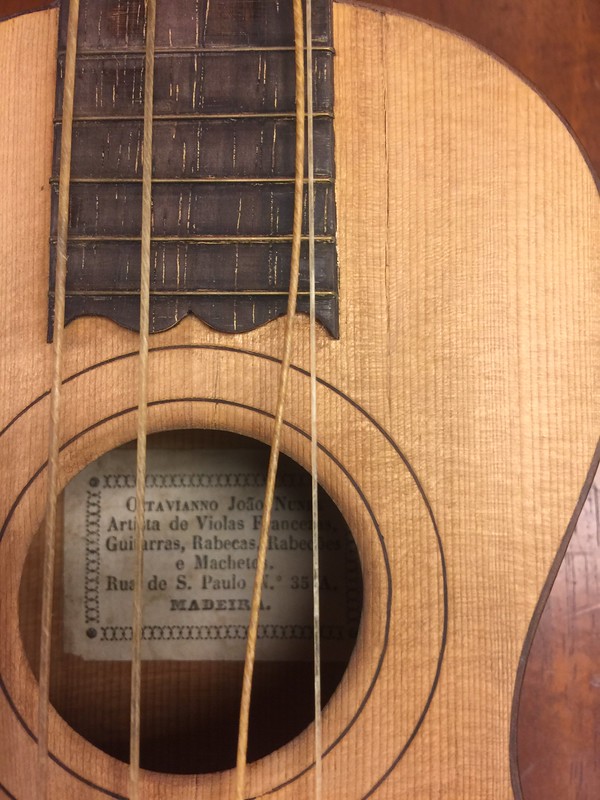braguinha
Small guitar with four strings (today made of steel) that emerged in mid-19th century on the island Madeira  , originating from the Cavaquinho. It is usually tuned D-G-H-D. In terms of size, it corresponds to the ukulele, whose direct precursor it became along with the rajão after its introduction to Hawaii in 1879. However, its tuning is not reentrant.
, originating from the Cavaquinho. It is usually tuned D-G-H-D. In terms of size, it corresponds to the ukulele, whose direct precursor it became along with the rajão after its introduction to Hawaii in 1879. However, its tuning is not reentrant.
Pictures
Octavianno Joao Nunes: Braguinha
Made before 1879 in Funchal on Madeira. Stored in a custom-made box from koa, therefore certainly taken to Hawaii in 1879. Octavianno was the uncle of Manuel Nunes.
Comments
The Machette
It has four single strings which are adjusted and tuned in the same way as the guitar (to bridge-pins and pegs) to the notes — [D-G-H-D]
Sometimes the violin tuning is adopted, but the above is correct and most suitable to the instrument. The machette is held in the left hand and the notes stopped between the frets – just as with the ordinary guitar – the tone being generally produced by vibrating the strings with the thumb of the right hand, and occassionally – for arpeggio chords – the nails of the right hand fingers. It is peculiar to the Portuguese and is rarely heard away from Portugal or Madeira. It has a pleasing tone and is often employed with effect in duets for either Portuguese guitarra or guitar.1)
In the machetes that have reached us from the 19th century, the more common morphological characteristics of this hand chordophone are the following: body in the shape of an eight with unpronounced waist; top and back, flat or with a slight bulge, parallel or funnelling towards the heel; a neck which usually ends with a head made up of tuning keys in the shape of an eight leaning backward with four dorsal tuning keys; rebound scale over the top, divided chromatically by 12 to 17 frets of hand beaten brass; fixed bridge glued to the top where four holes were opened from side to side and where the buttons or pins are inserted – of hard wood, blackwood or bone – with which the strings are attached; the bridge is also inlaid with the saddle which is made of bone, wood or a piece of the same metal as the frets; the saddle is usually finished with two small twisted moustache-like ends or rounded off; on the harmony top a hole is opened and ornamented by various inlaid concentric pieces of dark wood or by an elaborate inlay of dark and coloured woods – typical work of Madeira, as can be verified in the inlay art used on this island; at the base of the top it is also possible to find – in the more decorated and richer instruments – dark/light wood inlays (Brazilian black hart/rosewood/boxwood/holly) floral motifs; at the base of the body and at the top of the head are two bone buttons where a strap or string would be attached so as to enable the instrument to be carried on the shoulder; the string length is between around 250 mm (for the machete’s requinta) and 345 mm for the remaining instruments built from mid 19th century and the beginning of the following century. The wood used in the building of the machete from Madeira is (whenever possible endemic): for the harmony top (made up of two pieces) “Flanders pine” or “Venetian pine” (general terms the resin woods Epicia excelsa and Epicea abies); the sides (or flanks) and bottom, normally of just one piece, although they may also be built in two halves – cedar (Juniperus oxicedrus, also island or of the land pine) black til (Ocotea foetens), Phoebe indica wood and more rarely maple wood; on the harmony top an inlay may be inserted to reinforce its edges; the neck is of chestnut, cedar, Phoebe indica or mahogany (in the more recent instruments); the tuning keys head is of til or hard wood; the bridge is made of a hard wood such as Lignum vitae wood (Guiaiacum or another of the same family) or til; the scale is of black wood or til; the tuning keys are of black wood, til or darkened boxwood (Buxus sempervirem).2)
References
- Manuel Morais: The Madeira Machete
2)
Manuel Morais: The Madeira Machete







